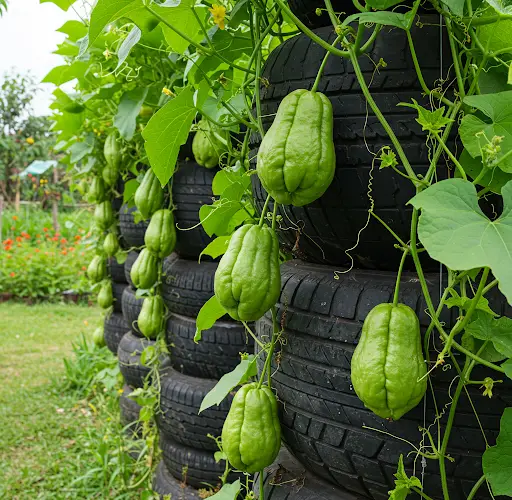Chayote, also known as vegetable pear or mirliton, is a vigorous climbing plant known for its crisp texture and mild flavor. While many gardeners dream of a lush trellis loaded with fruit, few realize how easy and cost-effective it can be—especially when using old tires as a planting base. Repurposing tires not only reduces waste but also creates an ideal environment for chayote vines to thrive, even in limited space.
This guide explores the surprisingly simple yet highly productive method of growing chayote using old tires and a sturdy trellis, transforming your garden—or even a corner of your yard—into a chayote-producing machine.
Why Choose Tires to Grow Chayote?
Old tires offer a number of advantages for growing chayote:
-
Excellent insulation: Tires help retain warmth in the soil, which encourages healthy root growth.
-
Moisture retention: The circular structure helps conserve moisture during dry spells.
-
Space optimization: They allow vertical growth in small areas when paired with a trellis.
-
Recycling benefit: It’s an eco-friendly way to reuse materials that would otherwise go to waste.
Using tires creates a raised planting bed that gives roots room to develop while also giving vines the height they need to climb and spread.
What You’ll Need
To begin your chayote-growing adventure with old tires, gather the following:
-
1–2 healthy chayote fruits (slightly sprouted is ideal)
-
1–2 old tires (cleaned and free of debris)
-
Rich, well-draining soil mixed with compost
-
Organic fertilizer (e.g., composted manure or kitchen waste)
-
A trellis, arch, or other vertical support structure
-
Mulch (optional)
-
A sunny location (at least 6–8 hours of sunlight daily)
Step-by-Step: How to Grow Chayote in Tires
1. Prepare the Tire Bed
Stack one or two old tires in a sunny spot where the vines can climb freely. Place them directly on soil so roots can penetrate deeper as the plant matures. Fill the interior with a nutrient-rich mixture of compost and garden soil. You can also layer in organic waste like banana peels or crushed eggshells to add natural nutrients.
2. Select and Prepare the Chayote
Choose a mature chayote fruit that has just begun to sprout. If yours hasn’t sprouted yet, let it sit in a warm, dark area for a few days until it begins to show green shoots from the seed inside.
Do not cut or peel the fruit. Plant the entire chayote at a 45-degree angle, with the sprouting end facing up, and bury it halfway in the soil in the tire. The fruit itself will decompose and nourish the growing seedling.
3. Install a Trellis
Chayote is a vining plant that grows vigorously and needs strong vertical support. Install a trellis, metal fence, or bamboo pole structure behind or over the tire. The vines will latch on and climb, producing flowers and eventually fruit along the way.
If space allows, you can create a chayote “arch” using PVC pipe, bamboo, or repurposed materials to support the vines. This not only supports the plant but creates a shaded, beautiful green tunnel of fruit.
4. Watering and Maintenance
Chayote plants need regular watering, especially during the flowering and fruiting stage. Keep the soil moist but not soggy. Water at the base of the tire and avoid wetting the leaves to prevent mildew.
Apply organic fertilizer monthly. A mixture of compost tea, diluted fish emulsion, or fermented banana peel solution helps promote flowering and fruiting.
Mulch around the base of the tire to retain moisture and suppress weeds.
When to Expect Fruit
Chayote is typically ready to harvest 90 to 120 days after planting, depending on your climate and care. You’ll first see small green flowers, which soon give way to baby fruits. Once the fruit reaches the size of a pear and is firm to the touch, it’s ready to harvest.
Check regularly, as chayote can produce continuously in warm weather. Harvesting frequently encourages the plant to keep producing.
Tips for Maximum Yield
-
Train the vines: Guide them along the trellis or arch to ensure even growth.
-
Keep pests away: Use natural deterrents like neem spray or garlic-infused water if needed.
-
Harvest regularly: Leaving overripe fruits on the vine can reduce overall yield.
-
Save the best fruit: Allow one mature fruit to fully ripen on the vine for next season’s planting.
Conclusion
Growing chayote on old tires is not only practical but also highly rewarding. With minimal investment and space, you can grow a vine heavy with fruit that feeds your family for months. This low-cost, eco-friendly technique proves that even urban or small-space gardeners can enjoy the bounty of a productive chayote harvest.
Whether you’re an experienced gardener or a beginner, this method offers a sustainable, straightforward path to success—one tire at a time.



